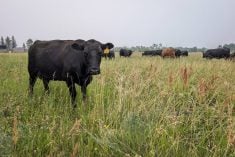CHICAGO (Reuters) — Chicago Mercantile Exchange lean hogs futures fell three cents, as much as the market allows, on Friday as wholesale pork pricing cooled and cash hog prices weakened.
CME feeder and live cattle prices also fell sharply in response. Livestock traders worried that wholesale prices of bacon and pork chops may still be too rich for retailers or consumers to swallow. Adding to the mix were slumping wholesale beef values and expectations of lower cash cattle trades.
That resulted in most-active May feeder cattle contracts closing down 1.625 cents per pound at 178.525 cents, while most-active June live cattle closed down 2.575 cents per lb at $134.800 cents.
Read Also

U.S. livestock: Cattle futures mixed
Cattle futures on the Chicago Mercantile Exchange were mixed on Thursday, after dropping sharply the previous session. The December live…
Friday capped a volatile trading week, which saw cattle futures whipsawing and hog futures plummeting as investors and traders tried to wrestle with uncertainty over the impact of a deadly swine virus on the hog herd.
Hog futures were the biggest driver of the price swings, said Dale Durchholz, senior market analyst at Agrivisor LLC.
“Hogs is where everything started. And that’s where everything stopped,” Durchholz said. “The big problem we have is your big trading funds, where they’ve built the biggest longs in the protein complex.”
Durchholz said that the funds shed their positions over questions that have arisen since last Friday’s U.S. Department of Agriculture Hogs and Pigs report, which found that the current supply of animals was significantly higher than analyst estimates. Traders and analysts wonder whether the spread of porcine epidemic diarrhea virus, which can be fatal to piglets, is having a less-than-feared impact on hog farms.
Meanwhile, several packers have reduced plant hours or days of operation to offset a hog shortage pegged to the spread of the virus. The uncertainty is making the market jittery, traders said.
“There’s one truth I know: When you have a market that went up like hogs did, it’s going to go down faster,” Durchholz said. “Now the question is, where’s the price that people are comfortable with buying June hog (futures contracts) with reasonable risk?”
At the close, April hogs fell 2.600 cents per lb to 123.150. May hogs closed down 3.000 cents per pound to 120.500; June hogs closed down 3.000 cents per lb at 120.550; July hogs closed down 3.000 cents per lb to 117.550; and August hogs finished 3.000 cents per lb lower at 117.150.
Uncertainty rippled out to the CME live and feeder cattle prices, as both traded sharply lower amid the pressure of CME hog futures and signs of little trading in the cash market.
“While hogs and cattle do influence each other’s pricing, we’re also at that seasonal point where you start to think the highs — at least in cash cattle — are behind you,” said University of Missouri livestock economist Ron Plain.
In the cash market, very light cattle bids came in late Thursday, of about 190 head, in Kansas with a price of about $150 per cwt, according to a trader and USDA data. Another 494 head in Nebraska at about $152 to 153, according to a trader and USDA data.
Last week, cash cattle in Texas and Kansas commanded a record high of $152 per cwt, and Nebraska cash cattle hit a $154 record, feedlot sources said.
April live cattle closed down 2.100 cents per lb at 143.050 cents, while August finished 2.475 cents per lb lower at 132.275 cents.
April feeder cattle closed down 1.125 cents per lb at 177.700 cents, and August ended 1.600 cents per lb lower at 180.225 cents.














